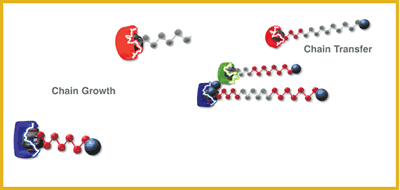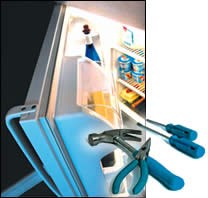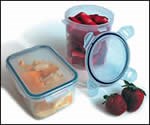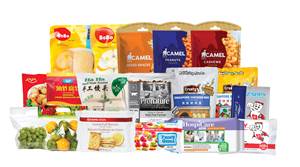New Olefin Block Copolymers Stretch TPE Processability and Cost Performance
A developmental family of novel olefin block copolymers (OBCs) from Dow Chemical Co. is lauded as a breakthrough in olefinic thermoplastic elastomers due to a unique block structure, which reportedly delivers novel combinations of end-use properties and processability at a “cost-in-use” competitive with materials such as TPVs, TPUs, and styrenic block-copolymer (SBC) TPEs.
A developmental family of novel olefin block copolymers (OBCs) from Dow Chemical Co. is lauded as a breakthrough in olefinic thermoplastic elastomers due to a unique block structure, which reportedly delivers novel combinations of end-use properties and processability at a “cost-in-use” competitive with materials such as TPVs, TPUs, and styrenic block-copolymer (SBC) TPEs. Dow’s new OBCs, trade named Infuse, also reportedly provide performance advantages over EVA and flexible PVC. Dow sees opportunities for processors of flexible molded goods, extruded profiles, hose, tubing, elastic fibers and films, foams, coated fabrics, tapes, and melt adhesives.
Though not yet commercially available, Infuse OBCs were publicly unveiled at June’s NPE show in Chicago. They reportedly provide customer-requested property improvements over Dow’s metallocene-based Engage polyolefin elastomers (POEs), which are ethylene-octene random copolymers. Those improvements include at least 40° C higher heat resistance, faster processing, much better abrasion resistance (a weakness of POEs), and improved compression set at high and low temperatures. Dow sees continued opportunities for Engage as an impact modifier in TPOs, but Infuse appears to offer a much wider potential as TPE molding and extrusion resins. They were developed with “post-metallocene” catalysts under Dow’s Insite technology platform.
Currently produced at a pilot plant at Freeport, Texas, the first Infuse grades will be announced by year’s end and are aimed at applications from footwear and athletic equipment to diapers and personal-care products.
‘Chain shuttling’ is key
Dow produces the new OBCs using its existing continuous solution process and equipment. As described by global v.p. of research and development Kurt Swogger, the first OBCs Dow has developed consist of regularly alternating amorphous soft blocks of Engage-type ethylene-octene elastomer and more crystalline hard blocks of linear MDPE. The process uses two non-metallocene catalysts, each of which produces only one type of block. One catalyst produces the amorphous polymer and the other makes the “hard” PE resin. (The latter catalyst, which can make either linear PP or MDPE, was first patented by Mitsui Chemicals in Japan. Dow and Mitsui have now entered into a joint research agreement to further develop catalyst systems for making olefin block copolymers.)
Since each catalyst does only one thing, the key to getting them to work together to make block copolymers is a non-catalytic “chain-shuttling agent” that transfers growing polymer chains back and forth between the two catalysts. An analogy would be two people knitting a single sweater, one using only blue yarn and one using only red yarn. If the sweater were passed back and forth between the two knitters repeatedly, the result would be a red-and-blue striped sweater.
Unusual properties
Infuse OBCs boast 50° to 60° C higher crystallization temperatures than random ethylene-octene copolymers, thus allowing them to set up faster in processing. In addition, OBCs are said to have elastic recovery comparable to SBCs but with higher heat resistance. Their compression set reportedly is better than PVC and EVA and almost equal to TPV. And OBCs’ adhesive properties are similar to SIS (styrene-isoprene-styrene). All these benefits come with lower “cost in use,” Dow says.
Initial applications are apt to include ones where TPVs or SEBS currently reign—flexible extruded profiles such as refrigerator gaskets as well as flexible molded goods, particularly soft-touch automotive and appliance parts.
Another area of potential for OBCs is elastic films, where Affinity metallocene ULDPE elastomers already fill a niche in applications that require up to 100% stretch. But OBCs offer up to 300% stretch and superior elastic recovery at elevated temperatures, suiting them to uses such as diapers and adult incontinence products.
Foam applications dominated by crosslinked EVA, crosslinked PE, SEBS, and flexible PVC are also targets for OBCs. Sport pads and cap liners for carbonated soft drinks or hot-fill bottles are examples of applications where OBCs reportedly can produce foams with lower compression set, lighter weight, and good sealing properties.
Hot-melt adhesives, where Affinity elastomers and SIS are well en trenched, is yet another area for OBCs. Applications include diapers, labels, and tape, some of which are pressure-sensitive. “The soft segment of OBCs provide the good adhesion while the hard segment provides the temperature resistance,” notes Swogger. “OBCs will be targeted at higher-end applications in this market and at lower cost than SIS.”
Related Content
Fundamentals of Polyethylene – Part 5: Metallocenes
How the development of new catalysts—notably metallocenes—paved the way for the development of material grades never before possible.
Read MoreThe Fundamentals of Polyethylene – Part 2: Density and Molecular Weight
PE properties can be adjusted either by changing the molecular weight or by altering the density. While this increases the possible combinations of properties, it also requires that the specification for the material be precise.
Read MoreFlexible-Film Processor Optimizes All-PE Food Packaging
Tobe Packaging’s breakthrough was to create its Ecolefin PE multilayer film that could be applied with a specialized barrier coating.
Read MoreFundamentals of Polyethylene – Part 6: PE Performance
Don’t assume you know everything there is to know about PE because it’s been around so long. Here is yet another example of how the performance of PE is influenced by molecular weight and density.
Read MoreRead Next
Beyond Prototypes: 8 Ways the Plastics Industry Is Using 3D Printing
Plastics processors are finding applications for 3D printing around the plant and across the supply chain. Here are 8 examples to look for at NPE2024.
Read MoreMaking the Circular Economy a Reality
Driven by brand owner demands and new worldwide legislation, the entire supply chain is working toward the shift to circularity, with some evidence the circular economy has already begun.
Read MoreSee Recyclers Close the Loop on Trade Show Production Scrap at NPE2024
A collaboration between show organizer PLASTICS, recycler CPR and size reduction experts WEIMA and Conair recovered and recycled all production scrap at NPE2024.
Read More


















